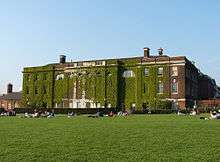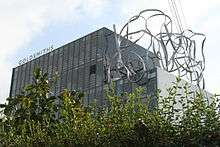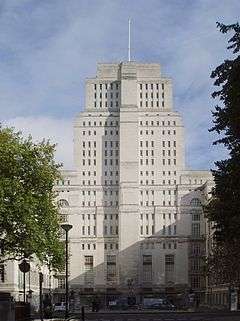Goldsmiths, University of London
 | ||||||||||
| Type | Public | |||||||||
|---|---|---|---|---|---|---|---|---|---|---|
| Established |
1904, Constituent College of University of London 1891 – Goldsmiths' Technical and Recreative Institute | |||||||||
| Endowment | £2.9 m (as of 31 July 2015)[1] | |||||||||
| Chancellor | HRH The Princess Royal (University of London) | |||||||||
| Warden | Pat Loughrey | |||||||||
| Students | 9,345 (2016/17)[2] | |||||||||
| Undergraduates | 6,190 (2016/17)[2] | |||||||||
| Postgraduates | 3,155 (2016/17)[2] | |||||||||
| Location | London, United Kingdom | |||||||||
| Campus | Campus | |||||||||
| Colours |
| |||||||||
| Affiliations |
University of London Association of Commonwealth Universities | |||||||||
| Website | www.gold.ac.uk | |||||||||
|
| ||||||||||
Goldsmiths, University of London, is a public research university in London, England, specialising in the arts, design, humanities, and social sciences. It is a constituent college of the University of London. It was founded in 1891 as Goldsmiths' Technical and Recreative Institute by the Worshipful Company of Goldsmiths in New Cross, London. It was acquired by the University of London in 1904 and was renamed Goldsmiths' College. The word College was dropped from its branding in 2006, but Goldsmiths' College, with the apostrophe, remains the institution's formal legal name.[3]
Nearly 20% of students come from outside the UK, and 52% of all undergraduates are mature students (aged 21 or over at the start of their studies). Around a third of students at Goldsmiths are postgraduate students.
History

In 1891, the Worshipful Company of Goldsmiths, one of the City of London Livery Companies, founded Goldsmiths' Technical and Recreative Institute (more commonly referred to simply as the "Goldsmiths' Institute"[4]). The Goldsmiths' Company was established in the 12th century as a medieval guild for goldsmiths, silversmiths and jewellers. The Livery Company dedicated the foundation of its new Institute to "the promotion of technical skill, knowledge, health and general well-being among men and women of the industrial, working and artisan classes". The original Institute was based in New Cross at the former Royal Naval School building. (This building, which was designed by the architect John Shaw Jr, is now known as the Richard Hoggart Building and remains the main building of the campus today.)

In 1904, the Institute was merged with the University of London and was re-established as Goldsmiths' College. (The apostrophe was removed in 1993, and the word 'College' dropped in a rebranding in 2006). At this point Goldsmiths was the largest teacher training institution in the country. Training functions were later expanded to include refresher courses for teachers, the University Postgraduate Certificate in Education and an Art teacher's Certificate course. The College also ran its own Nursery School.
Shortly after the merger, in 1907, Goldsmiths added a new Arts building, designed by Sir Reginald Blomfield, at the back of the main building. During the Second World War it was decided to evacuate the faculty and students of the College to University College, Nottingham, a decision which proved wise both at the time and in hindsight, since the main building was struck by an incendiary bomb and gutted in 1940 (and not finally repaired until 1947).
During the 1960s Goldsmiths experienced a rapid expansion in student numbers. It is during this period that Goldsmiths began to establish its reputation in the arts and social science fields, as well as offering a number of new teacher training qualifications. The original main building was expanded, and the Lockwood Building, Whitehead Building, Education Building, Warmington Tower and St James's Hall were all built to accommodate the influx of new students. The university also acquired a number of historic buildings in the surrounding area, including the splendid former Deptford Town Hall and Laurie Grove Baths buildings. The Richard Hoggart Building, Deptford Town Hall and the Laurie Grove Baths all retain Grade II listed building status.
In 1988, Goldsmiths became a full College of the University of London and in 1990 received its Royal Charter. Among its wardens have been Richard Hoggart, Andrew Rutherford and Ben Pimlott. The current Warden is Pat Loughrey.[5]
In 2018, the former boiler house and public laundry of Laurie Grove Baths was refurbished and opened as Goldsmiths CCA.
Campus and location

Goldsmiths is situated in New Cross, a highly populated area of south-east London with a considerable art and music scene. The area is served by London Overground trains at New Cross and New Cross Gate.
The main building, the Richard Hoggart Building, was originally designed as a school (opened in 1844) by the architect John Shaw, Jr (1803–1870). The former Deptford Town Hall Building, designed by Henry Vaughan Lanchester and Edwin Alfred Rickards, acquired in 1998, is used for academic seminars and conferences. In addition to this Goldsmiths has built several more modern buildings to develop the campus, including the RIBA award-winning Rutherford Building completed in 1997, the Ben Pimlott Building designed by Will Alsop and completed in 2005, and the Professor Stuart Hall Building (formerly the New Academic Building) which was completed in 2010.
The library, or the Rutherford Building, has three floors and gives students access to an extensive range of printed and electronic resources. The third-floor library is believed to house the largest collection of audio-visual material in the UK. Goldsmiths' students, like all other students in the University of London, have full access to the collections at Senate House Library at Bloomsbury in central London.

The seven-storey Ben Pimlott Building on New Cross Road, complete with its distinctive "scribble in the sky" (made from 229 separate pieces of metal) has become a signature of modern Goldsmiths. It contains studio and teaching space for the Department of Art, as well as housing the Goldsmiths Digital Studios[6] and the Centre for Cognition, Computation and Culture.[7]
The Professor Stuart Hall Building (formerly the New Academic Building), situated next to the green, is home to the Media and Communications Department and the Institute for Creative and Cultural Entrepreneurship (ICCE).[8] Facilities include a 250-seat lecture theatre, seminar and teaching rooms, as well as a cafe with outdoor seating.
Academic profile
Faculties and departments
Art
The Department of Art at Goldsmiths is one of the leading fine art teaching and practice-based research centres in the world. The Head of Department is Dr Richard Noble. Notable alumni include Damien Hirst, Sarah Lucas, Steve McQueen, Gillian Wearing, Sabina Goldsmith and Graham Coxon.
Design
The Department of Design's approach to design practice grew from a concern for ethical and environmentalist design. This developed alongside research by John Wood, and others, which informs their research into metadesign. TERU, the Technology Education Research Unit, has been instrumental in understanding how design and technology work in schools, how to encourage learners towards creative interventions that improve the made world, and how to help teachers to support that process. The Writing Purposefully in Art and Design Network (Writing-PAD) has its main Centre at Goldsmiths. The Network now spans some 70 institutions across the art and design sector with 6 national and 2 International Writing PAD Centres.
Sociology
The Sociology Department include Nirmal Puwar, Yasmin Gunaratnam and Vikki Bell.
Cultural studies
The Media and Communications Department, as well as the Centre for Cultural Studies, include Scott Lash, Angela McRobbie, Nirmal Puwar and (formerly) Sara Ahmed.
Anthropology
The Department of Anthropology teaching staff include Keith Hart and David Graeber. The Department is known for its focus on visual anthropology. The realm of continental philosophy is represented with academics such as Saul Newman, Alberto Toscano and Jean Paul Martinon as well as Visiting Professors Andrew Benjamin and Bernard Stiegler. In the area of Psychology there is Chris French who specialises in the psychology of paranormal beliefs and experiences, cognition and emotion.[9] Saul Newman - notable for developing the concept of post-anarchism - is currently leading the department of politics.
English and comparative literature
The English & Comparative Literature Department is one of the university's largest and it covers English, comparative literature, American literature, creative writing and linguistics. Current academics include Blake Morrison, Chris Baldick, Uttara Natarajan and Peter Dunwoodie. Its work in comparative literature developed after a merger with the Department of European Languages, later joined by its Creative Writing section.
Music
The Department of Music has a number of notable alumni, including Malcolm McLaren, Katy B, James Blake, Tunday Akintan, Rosie Lowe, John Cale and A. G. Cook. The Research Centre for Russian Music, convened by Alexander Ivashkin until his death in 2014, is internationally renowned for its archives devoted to Prokofiev and Schnittke, and unique collections including of music by Stravinsky, and Russian Piano Music first editions. Brian Molko, lead singer of Placebo, studied Drama at Goldsmiths and graduated in 1993. While Molko is not a music alumnus, Placebo were one of the most successful British bands of the mid to late 90's.
Educational studies
The Department of Educational Studies teaches undergraduate, masters and doctoral courses, and is home to a large programme of initial teacher education (primary and secondary), based on partnership arrangements with over 1500 schools and colleges.
Additional academic programs
Goldsmith University paired with Tungsten Network in 2015 to develop a research program that explores advanced artificial intelligence techniques for Big Data and business practices. Known as Tungsten Centre for Intelligent Data Analytics, the program is based in the company's London office.[10]
Rankings
Global rankings | ||
| QS[11] | 396 | |
|---|---|---|
| THE[12] | 301-350 | |
| Complete[13] |
62 | |
| The Guardian[14] |
76 | |
| Times / Sunday Times[15] |
71 | |
In 2017, Goldsmiths' Media and Communications department was named the second best in the UK and 8th worldwide.[16]
Student life
Sports, clubs and traditions
Sports teams and societies are organised by the Goldsmiths Students' Union. The Union runs 18 sports clubs, 11 of which compete in either University of London Union or BUCS leagues.
The Students' Union runs 35 societies, ranging from political societies and identity-based societies (for example the Jewish society and the LGBT society) to interest-based societies (the Drama Society and the on-campus radio station Wired) and more.
Student media
Goldsmiths has a long history of student-led media platforms, including Smiths Magazine,[17] The Leopard newspaper,[18] and Wired radio.[19] The student media is run independently by students at the college.
Student housing
The university owns seven halls of residence:
- Batavia Mews
- Chesterman House
- Dean House
- Loring Hall
- Surrey House
- Surrey House Annexe
- Raymont Hall
Several of the halls include electricity bills and gas bills as part of rent. Free internet is also offered in some of the halls. Visiting international students are generally assigned accommodation in Loring Hall, Dean House or Chesterman House. Loring Hall currently holds around 400 students.
Students' Union
The union provides, among other things, catering facilities, a chaplaincy, a medical clinic, an advice service on academic and welfare issues and a state of the art gym for students' use.[20]
In October 2014, the union faced critical coverage, from student newspaper The Tab after voting down a proposal to commemorate Holocaust Memorial Day, with Education Officer Sarah El-alfy describing it as "Eurocentric" and "colonialist."[21][22] The Tab failed to mention that it was their writer, for a couple of years a Goldsmiths student himself, who tabled the proposal in the first place. El-alfy offered to help put forward a redrafted version of the motion for the following Student Assembly meeting. The Union issued a statement claiming "Redrafting motions and re-entering them at a later date isn’t unusual in Students’ Unions and shouldn’t be misinterpreted as opposition."[23][24]
In 2015 the student union Welfare and Diversity Officer, Bahar Mustafa, was caught up in a media controversy initiated on imageboard website 4chan, which was subsequently picked up by the Tab by the same writer as above and then UK tabloid the Daily Mail for appearing to ban white people and men from a student union event, a tea drinking event specifically organised for BME female students.[25][26] Bahar Mustafa caused more public controversy through her justification of the ban, after being at the receiving end of a sustained online and telephone bullying wave which included rape and death threats as well as doxxing of her and her family.[27][28] and through her use of the hash tag #KillAllWhiteMen. A group of students petitioned for a vote of no confidence in her, but the petition was signed by less than 3% of the student body and therefore failed to trigger a referendum.[29][30]
Notable alumni
Goldsmiths' alumni have been influential in the fields of art, design, visual arts, film, journalism, literature, theatre, comedy, music, politics, history, and sport.
Alumni of the Department of Art include Mark Wallinger, Damien Hirst, Antony Gormley, Sam Taylor-Johnson, Lucian Freud, Mary Quant, Bridget Riley, Sarah Lucas, Gary Hume, Steve McQueen, Carl Hopgood, Ely Dagher, Michael Dean and Gillian Wearing, Brian Molko. The Department of Music's better known alumni include Malcolm McLaren, Katy B, James Blake, Rosie Lowe, John Cale and A.G. Cook. Others include the TV presenter Dave Myers, singer songwriter and innovator Beatie Wolfe, BBC weather presenter Wendy Hurrell, Film Director and Editor in Chief of Kurdish Question Mehmet Aksoy.
Another pair of notable people graduating from Goldsmiths’ are the founding members of the British rock band Blur, Damon Albarn and Graham Coxon.
See also
References
- ↑ "Annual Reports and Financial Statements - For the Year Ended 31 July 2015" (PDF). 2015-07-31. Retrieved 2018-05-20.
- 1 2 3 "2016/17 Students by HE provider, level, mode and domicile" (CSV). Higher Education Statistics Agency. Retrieved 25 March 2018.
- ↑ "Rebranding FAQs". Goldsmiths, University of London. Archived from the original on 25 February 2007. Retrieved 6 March 2007.
it is now known as Goldsmiths, University of London.
- ↑ "Goldsmiths' College archives". Aim25.ac.uk. 29 September 1905. Retrieved 26 April 2010.
- ↑ "Revealed: BBC boss who landed £866k payoff and walked straight into another public-sector job". Daily Mail. London.
- ↑ "Goldsmiths Digital Studios".
- ↑ "Centre for Cognition, Computation and Culture". Archived from the original on 16 May 2011.
- ↑ "ICCE".
- ↑ Wignall, Alice (18 January 2005). "What it's like to work at... ...Goldsmiths College, University of London". The Guardian. Retrieved 24 July 2013.
- ↑ "Goldsmiths University of London. Tungsten Corporation and Goldsmiths announce artificial intelligence venture". Goldsmiths University of London. April 28, 2015. Retrieved February 15, 2017.
- ↑ "QS World University Rankings 2019". Quacquarelli Symonds Ltd. Retrieved 6 June 2018.
- ↑ "World University Rankings 2019". Times Higher Education. Retrieved 26 September 2018.
- ↑ "University League Table 2019". The Complete University Guide. Retrieved 26 April 2018.
- ↑ "University league tables 2019". The Guardian. 29 May 2018. Retrieved 29 May 2018.
- ↑ "The Times and Sunday Times University Good University Guide 2019". Times Newspapers. Retrieved 23 September 2018.
- ↑ "Communication & Media Studies". Top Universities. 2017-03-02. Retrieved 2018-02-03.
- ↑ "SMITHS Magazine".
- ↑ "The Leopard newspaper".
- ↑ "Wired: Student radio for Goldsmiths College". Wired.gold.ac.uk. Retrieved 26 April 2010.
- ↑ "Save Goldsmiths Nursery campaign".
- ↑ "London University Row Over 'Eurocentric and Colonialist' Holocaust Remembrance Rejection". 16 October 2014. Retrieved 12 July 2016.
- ↑ "London students refuse to mark Holocaust Day - Jewish World". Retrieved 12 July 2016.
- ↑ "University union rejects 'eurocentric' Holocaust Memorial Day". Jewish News. 17 October 2015. Retrieved 24 May 2015.
- ↑ "Goldsmiths University Row As Holocaust Motion Voted Down Over 'Colonial' Fears". Huffington Post UK. 16 October 2015. Retrieved 24 May 2015.
- ↑ Agency (23 April 2015). "White people and men told 'please don't come' to student protest against inequality". The Telegraph. Retrieved 19 May 2015.
- ↑ Moyer, Justin Wm. (24 April 2015). "Excluding whites and men from diversity event at British university elicits anger". The Washington Post. Retrieved 19 May 2015.
- ↑ Rush, James (12 May 2015). "Goldsmiths Students' Union diversity officer explains she cannot be racist or sexist because she is an ethnic minority woman". The Independent. Retrieved 19 May 2015.
- ↑ "'I can't be racist if I'm from an ethnic minority'. Discuss". BBC. 13 May 2015. Retrieved 19 May 2015.
- ↑ "We call for a vote of no confidence on the current Welfare and Diversity Officer" (PDF). Goldsmiths Student Union. Retrieved 19 May 2015.
- ↑ Rush, James (27 May 2015). "Bahar Mustafa: Goldsmiths Students' Union diversity officer to keep her job after vote of no confidence petition fails". The Independent. Retrieved 12 July 2015.
